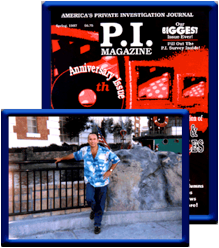By Christopher Goffard, P.I. Magazine
![]() Between August, 1994 and November 1995, robbers struck three separate Los Angeles County locations of the King Taco restaurant chain. The first incident resulted in a violent, seemingly interminable encounter between three restaurant employees and two armed gunman, who threatened to murder their captives execution-style. In the second and third incidents, thugs ambushed and robbed lone female employees as they carried restaurant receipts.
Between August, 1994 and November 1995, robbers struck three separate Los Angeles County locations of the King Taco restaurant chain. The first incident resulted in a violent, seemingly interminable encounter between three restaurant employees and two armed gunman, who threatened to murder their captives execution-style. In the second and third incidents, thugs ambushed and robbed lone female employees as they carried restaurant receipts.![]() With roughly $50,000 stolen altogether, and fear mounting among employees —- it seemed only a matter of time before one of them took a bullet —- the Sheriff’s Department had no one in custody and, with no dearth of homicides to consume their attention, no time for the exhaustive digging the case required.
With roughly $50,000 stolen altogether, and fear mounting among employees —- it seemed only a matter of time before one of them took a bullet —- the Sheriff’s Department had no one in custody and, with no dearth of homicides to consume their attention, no time for the exhaustive digging the case required.![]() Days after the third robbery, King Taco president Raul Martinez hired a private detective. He chose Al Adams Moreno, an ex-LAPD cop who runs a P.I. agency out of Newport Beach called Global Investigations. Moreno’s physical presence speaks of his years on the force, and of his stint before that as a Marine in Vietnam. Every muscle and mannerism suggests lashed-in violence, volcanic power held carefully in check. He knows the grammar of intimidation; he knows how to turn his voice and eyes into weapons on an instant’s notice.
Days after the third robbery, King Taco president Raul Martinez hired a private detective. He chose Al Adams Moreno, an ex-LAPD cop who runs a P.I. agency out of Newport Beach called Global Investigations. Moreno’s physical presence speaks of his years on the force, and of his stint before that as a Marine in Vietnam. Every muscle and mannerism suggests lashed-in violence, volcanic power held carefully in check. He knows the grammar of intimidation; he knows how to turn his voice and eyes into weapons on an instant’s notice.
![]() Those qualities helped him wrench a confession of guilt from a man initially considered a victim in the first crime —- Gilbert Marin, a King Taco supervisor and one of the company president’s most trusted employees. Convicted in August 1996 for conspiracy to commit armed robbery. Marin is now serving eight and a half years in prison.
Those qualities helped him wrench a confession of guilt from a man initially considered a victim in the first crime —- Gilbert Marin, a King Taco supervisor and one of the company president’s most trusted employees. Convicted in August 1996 for conspiracy to commit armed robbery. Marin is now serving eight and a half years in prison.![]() But linking the robberies to a culprit inside the company, amassing the evidence that allowed Moreno to win the confession, required grunt work —- 50 straight days spent taking painstaking notes, interviewing witnesses multiple times and following every conceivable lead.
But linking the robberies to a culprit inside the company, amassing the evidence that allowed Moreno to win the confession, required grunt work —- 50 straight days spent taking painstaking notes, interviewing witnesses multiple times and following every conceivable lead.![]() He faced an obvious challenge; Cold crimes. By the tine he signed on for the case. More than 15 months had elapsed since the first robbery, and more than eight months since the second. The size of the King Taco company also proved daunting. “When you have a company of 400 people, you have 400 suspects,” Moreno says.
He faced an obvious challenge; Cold crimes. By the tine he signed on for the case. More than 15 months had elapsed since the first robbery, and more than eight months since the second. The size of the King Taco company also proved daunting. “When you have a company of 400 people, you have 400 suspects,” Moreno says.![]() The first crime occurred on August 8, 1994 at the chain busiest restaurant at 4504 East Third Street. It was a Monday, which meant the weekend’s cash receipts were in the building. As Gilbert Marin told police, he arrived at work that day around 7:50 a.m., and parked in the back lot. He was walking toward the building when two Hispanic men covered on him, threaded him with a gun, and forced him to open the door.
The first crime occurred on August 8, 1994 at the chain busiest restaurant at 4504 East Third Street. It was a Monday, which meant the weekend’s cash receipts were in the building. As Gilbert Marin told police, he arrived at work that day around 7:50 a.m., and parked in the back lot. He was walking toward the building when two Hispanic men covered on him, threaded him with a gun, and forced him to open the door.![]() Inside they confronted an employee, Teresa Menchaca, who was tallying receipts in a supervisor’s office. Thought this office and one next door featured visible floor safes, the gunman didn’t demand that Marin or Menchaca open them. The gunman seemed to be waiting for another employee, Roberto Morales —- one of four people in the company who possessed a key to a third office down the hall, where the substantial cash was stored in a floor vault.
Inside they confronted an employee, Teresa Menchaca, who was tallying receipts in a supervisor’s office. Thought this office and one next door featured visible floor safes, the gunman didn’t demand that Marin or Menchaca open them. The gunman seemed to be waiting for another employee, Roberto Morales —- one of four people in the company who possessed a key to a third office down the hall, where the substantial cash was stored in a floor vault.![]() When Morales arrived a few minutes later, the gunman demanded the money. Morales hesitated, and one of the thugs pistol-whipped him across the nose. Blood splatter Morales’s face and his glasses fell. The thugs demanded he open the vault. Morales later told police he tried to comply, but he couldn’t see with blood obscuring his vision and his glasses missing.
When Morales arrived a few minutes later, the gunman demanded the money. Morales hesitated, and one of the thugs pistol-whipped him across the nose. Blood splatter Morales’s face and his glasses fell. The thugs demanded he open the vault. Morales later told police he tried to comply, but he couldn’t see with blood obscuring his vision and his glasses missing.![]() The thugs hog-tied Morales with duct-tape and threatened to kill everyone if they didn’t get the cash. But by now roughly 15 minutes had passed; empty-handed, they fled through the back door.
The thugs hog-tied Morales with duct-tape and threatened to kill everyone if they didn’t get the cash. But by now roughly 15 minutes had passed; empty-handed, they fled through the back door.![]() As Moreno interviewed witnesses and walked them through the scene, several details pointed to an inside job. How did the gunman know Morales had the key to the room with the vault? How did they know what time Morales would arrive? Stranger still: Why did they seem utterly indifferent to the first two visible safes, unless they somehow knew the floor vault contained the real money?
As Moreno interviewed witnesses and walked them through the scene, several details pointed to an inside job. How did the gunman know Morales had the key to the room with the vault? How did they know what time Morales would arrive? Stranger still: Why did they seem utterly indifferent to the first two visible safes, unless they somehow knew the floor vault contained the real money?![]() Another element that troubled Moreno was the amount of time involved. ‘The standard robbery’s done with the shock factor,î Moreno says. ‘You stick the gun in their, they cooperate immediately, you get the money, you get the hell out. That was not how this was done.”
Another element that troubled Moreno was the amount of time involved. ‘The standard robbery’s done with the shock factor,î Moreno says. ‘You stick the gun in their, they cooperate immediately, you get the money, you get the hell out. That was not how this was done.”![]() And Moreno managed to elicit a startling fact —- one that police had missed —- while interviewing Teresa Menchaca: The robbers had called Gilbert Marin by his first name.
And Moreno managed to elicit a startling fact —- one that police had missed —- while interviewing Teresa Menchaca: The robbers had called Gilbert Marin by his first name.![]() The second robbery happened on March 18, 1995 at the King Taco at 4300 East Olympic Boulevard. At 5:20 p.m., a restaurant supervisor named Irene Ramirez carried the day’s cash receipts to her car, which was parked in the building’s rear lot. As she began to drive off, a male Hispanic appeared and leveled a gun at her through the window. He opened the driver’s-side door and grabbed the cash. Then he ordered her to put her face down on the steering wheel and made his escape.
The second robbery happened on March 18, 1995 at the King Taco at 4300 East Olympic Boulevard. At 5:20 p.m., a restaurant supervisor named Irene Ramirez carried the day’s cash receipts to her car, which was parked in the building’s rear lot. As she began to drive off, a male Hispanic appeared and leveled a gun at her through the window. He opened the driver’s-side door and grabbed the cash. Then he ordered her to put her face down on the steering wheel and made his escape.![]() Though the police report says $3,000 was stolen, Moreno puts the figure at $20,000. He discovered that just before the robbery Marin, who was Ramirez’s supervisor, had ordered her to park in the rear lot —- a place without witnesses or easy escape, ideal for an ambush.
Though the police report says $3,000 was stolen, Moreno puts the figure at $20,000. He discovered that just before the robbery Marin, who was Ramirez’s supervisor, had ordered her to park in the rear lot —- a place without witnesses or easy escape, ideal for an ambush.![]() Eight months later, at the King Taco at 5729 Atlantic Boulevard in Maywood, the third robbery occurred. This time a supervisor named Carmen Contreras was carrying a bundle of the restaurant’s cash to her car in the parking lot. It was 9:30 a.m. A male Hispanic rushed her from behind and shoved her into the car. Her beat her in the face and fled with the cash, which Moreno puts at around $30,000.
Eight months later, at the King Taco at 5729 Atlantic Boulevard in Maywood, the third robbery occurred. This time a supervisor named Carmen Contreras was carrying a bundle of the restaurant’s cash to her car in the parking lot. It was 9:30 a.m. A male Hispanic rushed her from behind and shoved her into the car. Her beat her in the face and fled with the cash, which Moreno puts at around $30,000.![]() Moreno discovered that Marin had ordered Contreras to change her normal pickup routine between restaurants that day, so that during the robbery she had about twice the usual cash in the possession.
Moreno discovered that Marin had ordered Contreras to change her normal pickup routine between restaurants that day, so that during the robbery she had about twice the usual cash in the possession.![]() Through Moreno exhausted days pursuing other suspects —- including an ex-King Taco security guard with a criminal past —- Marin emerged as the indisputable front-runner. Moreno knew he had been somehow complicit in the robberies. The motive crystallized when a background check revealed Marin had recently filed bankruptcy, and had borrowed money from the King Taco organization.
Through Moreno exhausted days pursuing other suspects —- including an ex-King Taco security guard with a criminal past —- Marin emerged as the indisputable front-runner. Moreno knew he had been somehow complicit in the robberies. The motive crystallized when a background check revealed Marin had recently filed bankruptcy, and had borrowed money from the King Taco organization.![]() “I knew my man was Gilbert Marin, but I knew they wouldn’t arrest him on a thing this heavy unless I got a written confession,” Moreno says.
“I knew my man was Gilbert Marin, but I knew they wouldn’t arrest him on a thing this heavy unless I got a written confession,” Moreno says.![]() When Marin failed a polygraph test, Moreno used this as a psychological wedge. Face-to-face in an interrogation room, Moreno unlashed the barrage of evidence and convinced him that others had already implicated him. “In a criminal investigation of this kind you basically have to tell the suspect how the hell he did what he did.” Moreno says. “You have to shock him. If you’re cold, if you’re just reaching, you’re gonna lose him.”
When Marin failed a polygraph test, Moreno used this as a psychological wedge. Face-to-face in an interrogation room, Moreno unlashed the barrage of evidence and convinced him that others had already implicated him. “In a criminal investigation of this kind you basically have to tell the suspect how the hell he did what he did.” Moreno says. “You have to shock him. If you’re cold, if you’re just reaching, you’re gonna lose him.”![]() Moreno employed a cunning ruse, telling Marin that King taco president Raul Martinez had agreed not to press charges if Marin would confess. “Mr. Martinez told me he would put it behind him,” Moreno said. “That’s how much he thinks of you.”
Moreno employed a cunning ruse, telling Marin that King taco president Raul Martinez had agreed not to press charges if Marin would confess. “Mr. Martinez told me he would put it behind him,” Moreno said. “That’s how much he thinks of you.”![]() Moreno gave him two choices: Confess now, and he would call Martinez. Don’t confess, and he would call the cops.
Moreno gave him two choices: Confess now, and he would call Martinez. Don’t confess, and he would call the cops.![]() “I can look in your eyes and see you’ve got not a 500-pound but a 1500-pound gorilla on your back,” Moreno told him. “This is not going to go away. I’m gonna give you an opportunity to tell me what the hell happened.”
“I can look in your eyes and see you’ve got not a 500-pound but a 1500-pound gorilla on your back,” Moreno told him. “This is not going to go away. I’m gonna give you an opportunity to tell me what the hell happened.”![]() Marin cracked. He signed three written confessions admitting complicity in the crimes. His excuse: Sinister characters —- possibly members of the Mexican Mafia —- had threatened to murder him and his family if he didn’t set up the robberies.
Marin cracked. He signed three written confessions admitting complicity in the crimes. His excuse: Sinister characters —- possibly members of the Mexican Mafia —- had threatened to murder him and his family if he didn’t set up the robberies.![]() As Moreno tells it, Martin seemed shocked when sheriff’s deputies arrived to arrest him. “I thought that you were gonna call Mr. Martinez,” Marin told Mareno. Moreno responded: “I lied.”
As Moreno tells it, Martin seemed shocked when sheriff’s deputies arrived to arrest him. “I thought that you were gonna call Mr. Martinez,” Marin told Mareno. Moreno responded: “I lied.”![]() In Superior Court in downtown Los Angeles, Deputy District Attorney Craig Renetzky made the case that greed motivated Gilbert Marin to orchestrate the crimes. On August 2, 1996, after an 11-day trial, the jury found him guilty on four felony counts, including conspiracy to commit armed robbery.
In Superior Court in downtown Los Angeles, Deputy District Attorney Craig Renetzky made the case that greed motivated Gilbert Marin to orchestrate the crimes. On August 2, 1996, after an 11-day trial, the jury found him guilty on four felony counts, including conspiracy to commit armed robbery.![]() Renetzky says he could not have taken the case to trial, much less won a conviction, without the evidence Moreno furnished. “You could almost say he single-handedly did it.” The prosecutor says. “It was prepared by him to the point that a homicide detective would prepare a murder case. He turned over every stone. And the defense, I think, was just overwhelmed.”
Renetzky says he could not have taken the case to trial, much less won a conviction, without the evidence Moreno furnished. “You could almost say he single-handedly did it.” The prosecutor says. “It was prepared by him to the point that a homicide detective would prepare a murder case. He turned over every stone. And the defense, I think, was just overwhelmed.”





